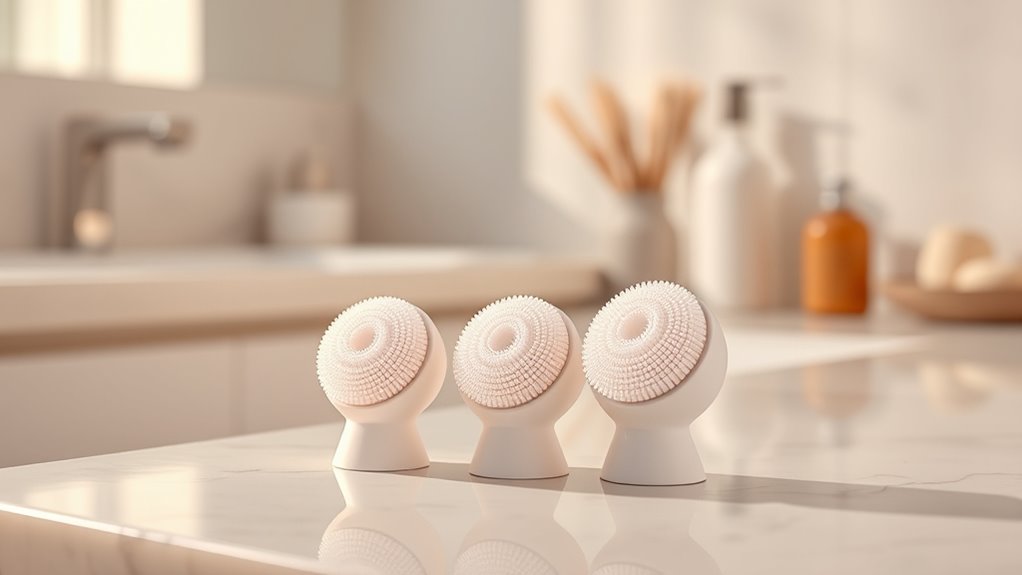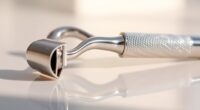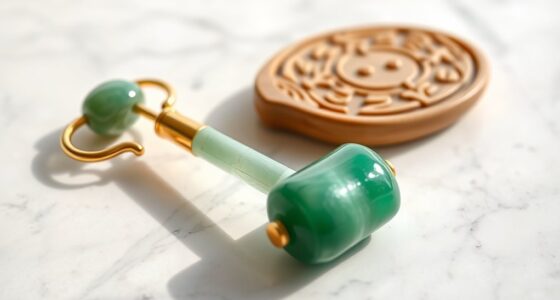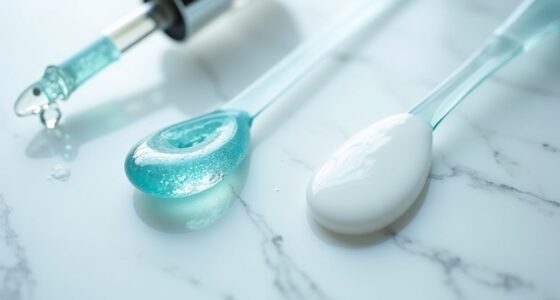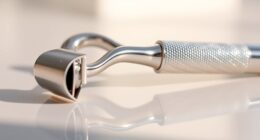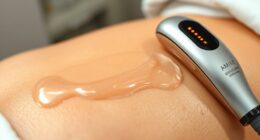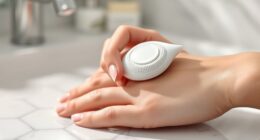You should replace your facial cleansing brush head every three to four months to keep it effective and hygienic. Frayed bristles, reduced cleaning power, or skin irritation are signs it’s time for a new one. Not replacing it can lead to bacteria buildup and breakouts. Proper maintenance helps extend its lifespan, but timely updates guarantee your skin stays healthy. Keep going to discover how to tell when it’s time for a change.
Key Takeaways
- Replace brush heads every 3 to 4 months for optimal hygiene and performance.
- Consider replacing sooner if bristles are frayed, bent, or less effective.
- Skin irritation or breakouts may signal it’s time for a new brush head.
- Sensitive skin types might need replacements closer to every 3 months.
- Regular replacement prevents bacteria buildup and maintains healthy skin.
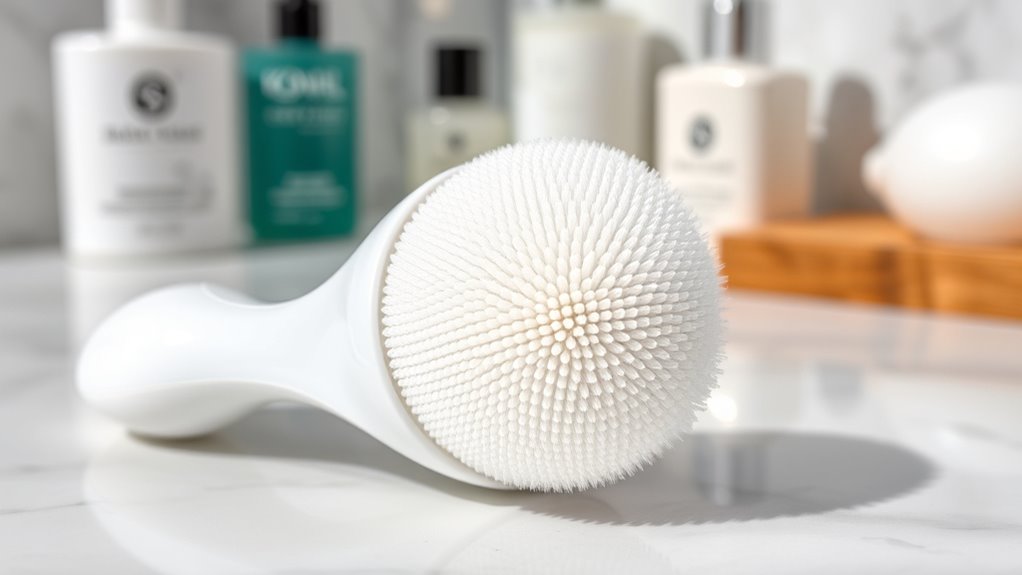
If you want your facial brush to work effectively and keep your skin healthy, it’s important to know when to replace the brush heads. Regular replacement is a key part of maintaining good skincare routines and ensuring your brush performs at its best. Over time, brush heads accumulate dirt, oil, dead skin cells, and bacteria, which can lead to breakouts, irritation, or infections if not replaced regularly. Knowing the right timeframe helps you avoid these issues and keeps your skincare routine effective.
Typically, experts recommend replacing your facial brush heads every three to four months. This interval strikes a balance between maintaining ideal hygiene and getting the most out of your device. However, the exact timing can vary depending on how often you use your brush, your skin type, and the manufacturer’s recommendations. If you have sensitive skin, you might need to replace the brush head closer to the three-month mark to prevent irritation. Conversely, if you use your brush less frequently or have tougher skin, you might stretch it closer to four months.
Pay close attention to the condition of your brush head. If you notice bristles becoming frayed, bent, or worn out, it’s time to replace it, regardless of how long you’ve been using it. A worn-out brush won’t clean your skin effectively and can even cause microtears, which increase the risk of infection. Also, if your skin starts to feel irritated, red, or shows signs of breakouts, it could be a sign that your brush head is harboring bacteria or isn’t cleaning properly, and replacing it might help resolve the problem.
Good brush maintenance involves more than just replacing the heads on schedule. You should also clean your brush regularly by rinsing it thoroughly after each use and allowing it to air dry to prevent bacterial growth. Store it in a clean, dry place and avoid sharing it with others to minimize cross-contamination. Maintaining proper toothbrush hygiene and following these steps ensures that your skincare routines remain effective and that your device stays in top condition.
Ultimately, replacing your facial brush heads at the right intervals is essential for healthy, glowing skin. It’s a simple step that offers big benefits—preventing breakouts, reducing irritation, and maintaining the overall effectiveness of your cleansing routine. By staying attentive to the condition of your brush and adhering to recommended replacement timelines, you’ll enjoy cleaner skin and maximize the longevity of your device.
Frequently Asked Questions
Can I Extend the Lifespan of My Facial Brush Heads?
You can extend the lifespan of your facial brush heads by regularly cleaning them and choosing brush head materials like silicone, which resist bacteria better. Follow the recommended replacement frequency—usually every 3 to 4 months—unless you notice wear or buildup. Avoid sharing brush heads, and store them in a dry, clean place. Proper maintenance helps keep your skin healthy and guarantees your device stays effective longer.
Are There Specific Signs That Indicate Replacement Is Needed?
Yes, there are clear signs that indicate it’s time for replacement. If you notice product longevity decreasing, such as less effective cleansing or persistent skin irritation, it’s time to swap out the brush head. Also, if you see visible wear, such as frayed bristles or buildup that won’t clean, these are signs your replacement frequency should be increased. Regularly checking these cues helps maintain ideal skin health and hygiene.
Do Different Skin Types Require More Frequent Replacements?
Did you know that sensitive skin types often benefit from replacing brush heads more frequently? If you have skin sensitivity, you should consider replacing your brush head every 3-4 months, especially if the brush material is coarse or prone to harboring bacteria. Regular replacement helps prevent irritation and maintains gentle cleansing. For oily or resilient skin, you might stretch to 4-6 months, but always listen to your skin’s reactions.
How Do Cleaning Habits Affect the Longevity of Brush Heads?
Your cleaning habits considerably impact the longevity of brush heads. If you maintain good hygiene practices, like rinsing your brush thoroughly after each use and allowing it to dry completely, it helps prevent bacteria buildup. Proper product storage, such as keeping the brush in a clean, dry place, also extends its lifespan. Neglecting these habits can lead to faster wear and increased risk of skin irritation, requiring more frequent replacements.
Is It Safe to Share Facial Brush Heads With Others?
Sharing facial brush heads is like inviting bacteria to a skin party—it’s not just unsafe, it’s risking major breakouts and infections. For your skin’s health, it’s best to avoid sharing due to hygienic concerns and sharing risks. Each person’s skin harbors different bacteria, and cross-contamination can lead to irritation or worse. Protect your skin’s health by using your own brush head and replacing it regularly.
Conclusion
So, don’t wait until your brush heads are worn out to replace them. Regular changes keep your skin fresh and prevent breakouts, ensuring you get the best results from your routine. Remember, a stitch in time saves nine—staying proactive with replacements saves you from bigger skincare headaches down the road. Keep an eye on your brush heads, and you’ll enjoy clearer, healthier skin without any unnecessary trouble. Stay vigilant, and your face will thank you!
